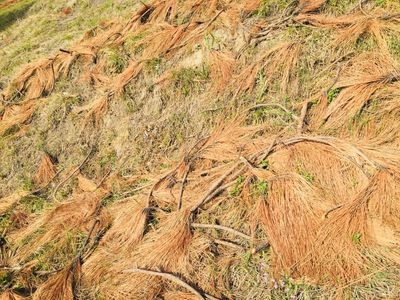Pine trees, with their evergreen beauty, are a cornerstone in many landscapes. However, when these majestic trees start showing brown needles, it raises a crucial question: can they be saved? This comprehensive guide delves into the causes, prevention, and revival strategies for pine trees with brown needles, offering a beacon of hope for gardeners and arborists alike.
Understanding the Underlying Causes of Brown Needles in Pine Trees
Symptoms and Diagnosis: Identifying the Issue Early
- Visual Signs: The first indication of distress in a pine tree is usually a change in the color of its needles. Instead of a vibrant green, they turn yellow, brown, or even red. This discoloration may start at the tips and work its way down or occur in patches.
- Seasonal Patterns: It’s essential to note the timing of these changes. Seasonal needle drop is a natural process, but if browning occurs outside of these typical patterns, it may signify stress or disease.
Common Causes: Environmental and Biological Factors
- Water Stress: Both over and under-watering can cause needles to turn brown. Pine trees require a balanced moisture level in the soil.
- Pest Infestations: Pests like pine bark beetles and weevils can cause significant damage, leading to browning needles.
- Disease Prevalence: Diseases such as pine wilt or needle blight can also contribute to discoloration and tree decline.
Preventive Measures to Protect Pine Trees
Cultivation Best Practices
- Correct Planting Techniques: Planting at the right depth and spacing is crucial. Pine trees need space for root expansion and adequate access to oxygen.
- Ideal Soil Mixtures: Using a soil mix that facilitates proper drainage and aeration is beneficial for pine health.
Regular Maintenance and Care
- Adequate Watering Regimes: Establishing a consistent watering schedule, especially for young or transplanted trees, is critical.
- Pruning Methods: Regular pruning helps maintain health and vigor, removing dead or diseased branches to prevent the spread of pathogens.
Integrated Pest Management Strategies
- Biological Controls: Introducing natural predators or beneficial insects can help control pest populations.
- Chemical Treatments: In severe cases, appropriate fungicides or insecticides may be necessary, applied according to environmental guidelines.
Revival Techniques for Pine Trees with Brown Needles
Immediate Actions for Damage Control
- Watering Adjustments: Modify watering practices to meet the tree’s current needs, depending on whether the issue is due to over or under-watering.
- Removal of Affected Areas: Pruning dead or diseased branches can help prevent further spread of damage.
Long-term Strategies for Tree Health
- Fertilization Plans: Implement a balanced fertilization regimen, tailored to the tree’s specific nutrient requirements.
- Soil Amendment Techniques: Adjusting the soil composition can improve nutrient uptake and overall health.
Monitoring and Ongoing Care
- Seasonal Checks: Regular inspections can help catch issues early, allowing for timely interventions.
- Growth Tracking: Monitoring growth patterns can provide insights into the tree’s overall health and response to treatments.
Landscape Integration and Pine Tree Health
Balancing Aesthetics and Tree Well-being
- Design Considerations: Incorporate pine trees into landscape designs in a way that considers their growth habits and needs.
- Species Selection: Choose species that are well-suited to the local climate and soil conditions.

How Do You Revive a Brown Pine Tree?
If your brown pine tree is looking a little worse for the wear, there are some things you can do to help it revived. First, check to see if the tree is getting enough water. If the soil around the base of the tree is dry, give it a good soak.
You can also try giving it a deep watering every two weeks. Be sure not to overdo it though, as too much water can actually be detrimental to the health of your pine tree.
Next, take a look at the needles on your pine tree.
If they are yellow or brown and falling off, that is an indication that the tree is not getting enough nutrients. Add some organic matter to the soil around the base of the tree such as compost or manure. This will help give your pine tree the nutrient boost it needs to revive itself.
Finally, make sure that your pine tree is getting enough sunlight. If it is growing in an area that is too shady, consider thinning out some of the surrounding trees or shrubs so that it gets more light exposure. With a little TLC, your brown pine tree will be back to its green and healthy self in no time!
What Causes Pine Needles to Turn Brown?
Pine needles turn brown for a number of reasons, the most common being drought stress. Other possible causes include nutrient deficiencies, herbicide injury, insect damage, and disease.
Drought is by far the most common cause of browning pine needles.
Pine trees are adapted to living in dry conditions, but they still need some water to stay healthy. When conditions are particularly dry, pine trees may start to shut down their operations in order to conserve water. This can lead to needle drop (when the tree sheds its needles) as well as needle browning.
Nutrient deficiencies can also cause pine needles to turn brown. If the soil where the pine tree is growing is lacking in certain nutrients, the tree may not be able to get enough of them through its roots. This can lead to problems with needle growth and coloration.
Commonly deficient nutrients include nitrogen, phosphorus, and potassium.
Herbicide injury is another potential cause of browning pine needles. If herbicides are used nearby and they drift onto the tree leaves, they can damage or kill them.
This will usually result in widespread needle browning or loss across the entire tree.
Insect damage can also cause browning or dying pine needles. There are a number of different insects that feed on pine needles, including caterpillars, beetles, and mites.
Is It Normal for Pine Trees to Turn Brown in the Fall
As the temperatures start to cool down and the leaves begin to change color, you may notice that your pine trees are turning brown. While this may seem like a cause for concern, it is actually perfectly normal for pine trees to turn brown in the fall.
There are a few reasons why this happens.
Firstly, as the days get shorter and the nights get longer, the tree’s metabolism slows down and it stops producing chlorophyll. Chlorophyll is what gives pine needles their green color, so without it they will appear brown.
Secondly, as the weather gets colder, the tree’s cells will begin to shrink and collapse.
This causes the needles to curl up and turn brown at the tips.
Lastly, if there has been a drought or other stressor during the growing season, this can also cause the needles to turn brown in fall. Pine trees are very resilient though, so as long as they are getting enough water they will rebound just fine come springtime!
Pine Tree Needles Turning Brown in Summer
If you have pine trees in your yard, you may have noticed that their needles are turning brown. This is perfectly normal and nothing to worry about! Here’s a quick explanation of why this happens:
Pine trees need to shed their older needles in order to make room for new growth. So, every summer, they will drop some of their needles (usually the oldest ones). The needles will turn brown before they fall off, which is why you’re seeing them change color now.
There’s no need to worry about your pine tree if its needles are turning brown. This is just a natural process that happens every year as the tree renews itself.
Brown Needles on Pine Tree
If you notice brown needles on your pine tree, it could be a sign of trouble. Needles can turn brown from too much sun, dehydration, insect damage, or disease. If the problem is severe, the tree may eventually die.
To save your pine tree, it’s important to figure out what’s causing the browning needles. If the tree is getting too much sun, try moving it to a shadier spot. If dehydration is the issue, water the tree deeply and regularly.
You may also need to treat for insects if they are present. Finally, if there is a disease present, you’ll need to take specific steps to treat it and prevent it from spreading.
If you’re not sure what’s causing the browning needles on your pine tree, contact a certified arborist or other tree expert for help.
With proper care, you can save your pine tree and keep it healthy for years to come!
Can Brown Pine Needles Turn Green
Brown pine needles are a sign of stress in the tree. The tree may be experiencing a drought, too much sunlight, or damage from insects. If you see brown pine needles on your trees, it’s important to take action to help the tree recover.
Here are some tips:
-Water the tree deeply and regularly during periods of drought.
-Make sure the tree has enough shade during hot weather.
-Prune away any damaged branches where insects have been feeding.
By taking these steps, you can help your brown pine needles turn green again!
How to Tell If a Pine Tree is Dying
If you think your pine tree may be dying, there are several things you can look for to be sure. First, check the needles. If they’re brown and dry, or falling off the tree, that’s a bad sign.
You should also check for any signs of fungus or pests. If the bark is cracked or peeling, that’s another indication that something is wrong. Finally, take a look at the overall shape of the tree.
If it’s leaning to one side or appears unhealthy, it may be time to say goodbye.
Final Takeaway
It’s not uncommon for pine trees to turn brown in the winter. However, if your pine tree is turning brown in the summer, it could be a sign of a problem. There are several things that could be causing your pine tree to turn brown, including disease, pests, or drought.
If you’re not sure what’s causing the problem, it’s best to consult with a tree expert. Once you’ve determined the cause of the problem, you can take steps to save your pine tree.



